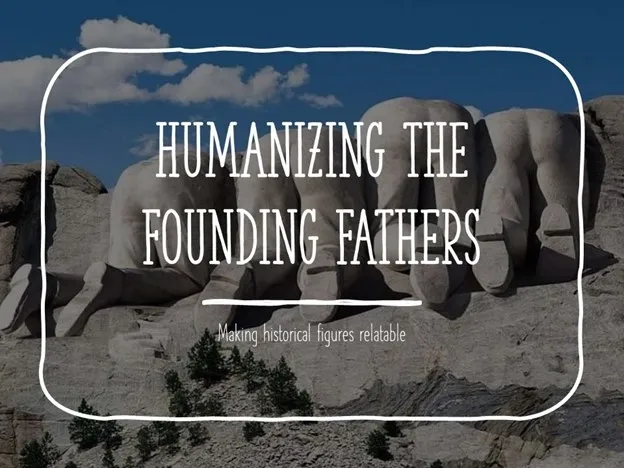by Jeff Swisher | Morton High School
The purpose of this post stems from a time I visited Mount Rushmore. Gazing up, you’re confronted with images of our founding fathers, depicted on a literally “larger than life” scale, which can feel quite surreal. I once stumbled upon a poster that humorously humanized them, reminding me that they, too, were ordinary people with their own fears, challenges, mistakes, and triumphs.
Teaching history is a task filled with responsibility and challenges. One of the most formidable tasks is to present historical figures, especially the Founding Fathers of America, as actual, complex humans rather than lofty, impersonal figures or idols etched in marble. The reality is that these individuals possessed virtues, flaws, motivations, fears, and desires just like us. Their decision-making processes were as nuanced as ours, and their actions were influenced by their unique personal and historical circumstances.
This post delves into an array of strategies to assist educators in their mission to humanize the Founding Fathers in their teaching. We aim to aid educators in portraying the Founding Fathers not as untouchable figures but as multifaceted individuals who lived, thought, and decided in a context and era distinct from ours.
Providing Context
Understanding the Founding Fathers begins with understanding their era. All their actions, decisions, and beliefs were shaped by the societal, political, and economic landscape they navigated. The 18th century was an era marked by upheaval and transformation, both in America and globally. The Age of Enlightenment was bringing new ideas about governance and human rights to the fore. Simultaneously, conflicts and tensions were brewing with the British Crown.
Incorporating this historical context into lessons is crucial. It not only humanizes these historical figures but also helps students appreciate that historical decisions were not made in a vacuum. Students can better comprehend why the Founding Fathers made certain choices and how their decisions could be revolutionary in their context. Providing the contextual backdrop allows students to grasp that history is a flow of interconnected events and ideas.
Exploring Personal Lives
If we wish to humanize the Founding Fathers, understanding their personal lives is key. Beyond their well-known public personas, they were individuals with families, hobbies, passions, and personal struggles. Examining these aspects not only helps students relate to these historical figures but also provides insights into their actions and decisions.
Take George Washington, the first President of the United States and the commander of the Continental Army during the American Revolutionary War. Students are typically familiar with these roles. However, beyond his military and political life, Washington was a farmer at heart. He took great pride in his Mount Vernon estate, where he experimented with crops and livestock, tested new farming techniques, and enjoyed the tranquility that the rural life provided. Sharing these aspects allows students to see a different side of Washington that might feel more relatable and familiar.
Washington was also a stepfather. His marriage to Martha Custis brought two stepchildren into his life. Despite the tragic loss of both his stepchildren at a young age, he took his role as a father seriously, guiding them with affection and responsibility. Washington’s experiences with family life – the joys, the sorrows, and the responsibilities – further humanize him, revealing him to be not just a leader of a nation, but also a man navigating the complexities of family dynamics.
Consider also Benjamin Franklin, a Renaissance man revered for his inventions and his role in shaping the U.S. Constitution. Students might be surprised to learn that Franklin had a lively personality. He was known for his wit and humor, and he loved social gatherings. His international travels, particularly to France, were marked by his jovial nature and ability to charm those he met. Franklin was also known to be a flirt, a trait that brought him both admiration and criticism.
Franklin was also a devoted writer, leaving behind a wealth of letters, essays, and an autobiography that provide us with insights into his thoughts and feelings. These writings reveal his inquisitiveness, his values, his regrets, and his humor, painting a rounded picture of Franklin the man, not just Franklin the statesman and scientist.
When teaching about the Founding Fathers, sharing these personal aspects of their lives can offer students a more relatable understanding of these historical figures. They were not just leaders and politicians; they were individuals navigating the challenges and joys of life, just like us. This balanced perspective can engage students more effectively and foster a deeper connection with the past.
Emphasizing Their Imperfections
To present a holistic view of the Founding Fathers, their imperfections and controversies need to be emphasized. They were not immune to faults and poor judgments, nor were they beyond the influence of the societal norms and prejudices of their time. This doesn’t diminish their achievements but presents them as fully formed individuals who had their personal failings and blind spots.
Many of the Founding Fathers, such as George Washington, Thomas Jefferson, and James Madison, were slaveholders. This fact often raises challenging questions from students: How could these individuals, who championed the cause of freedom and equality, continue to hold other human beings in bondage? Such questions provide opportunities for deep and critical discussions about morality, hypocrisy, and the societal norms of the time.
Take Thomas Jefferson, the primary author of the Declaration of Independence, a document that pronounces the belief that “all men are created equal.” And yet, Jefferson was a lifelong slaveholder who held conflicting views about slavery. He recognized it as a moral evil but couldn’t envision a practical way to end it or to integrate an enslaved population into society. The paradox of Jefferson’s views on freedom and his status as a slaveholder presents a complex, flawed, and human picture of him.
The Founding Fathers also had personal rivalries, disagreements, and grudges. The animosity between Alexander Hamilton and Aaron Burr culminated in a duel that cost Hamilton his life. Such episodes underline that these men were not always paragons of virtue or wisdom; they made mistakes, acted impulsively, and let personal feelings influence their actions.
Presenting the Founding Fathers, warts and all, humanizes them. It allows students to grapple with their complexity, to question their actions, and to understand that these historical figures were products of their time, susceptible to the same human frailties as everyone else. This approach fosters a more nuanced understanding of history and encourages critical thinking among students.
Analyzing Their Decisions and Motivations
One of the most effective ways to humanize the Founding Fathers is to delve into their decisions and motivations. Analyzing why they made certain choices helps students see these individuals as real, thinking beings, grappling with dilemmas and making decisions based on a complex interplay of personal beliefs, external influences, and societal pressures.
Take Thomas Jefferson’s proclamation, “all men are created equal,” as an example. This powerful statement stands as one of the foundations of American democracy. And yet, Jefferson was a slave owner. How do we reconcile this glaring contradiction? Delving into this question invites a rich discussion about Jefferson’s motivations and the complexities of his decision-making process.
One must consider that Jefferson, like many of his contemporaries, was a product of his time and circumstances. His views on equality were progressive for his era and influenced by Enlightenment thinkers. However, his position as a slave owner was a common practice among the Virginia planter class to which he belonged. His complicated views on race and slavery were shaped by societal norms, economic factors, and personal biases.
This type of critical analysis can be extended to other Founding Fathers and their decisions. Why, for instance, did Alexander Hamilton champion a strong central government and a financial system modeled after the British, despite fighting a war for independence from them? Hamilton was an immigrant from the Caribbean, born out of wedlock and with limited means. His rise to prominence was based on merit and hard work, and he believed in a system that rewarded such efforts. His experiences shaped his worldview, leading him to advocate policies he believed would create a prosperous and stable nation, even if they were unpopular among some of his contemporaries.
Consider also James Madison, hailed as the “Father of the Constitution.” Madison was a strong advocate for a system of government with checks and balances. What motivated this belief? Madison’s extensive reading, particularly about historical confederacies and their failings, influenced his conviction that a government should have a structure that prevents any single entity from gaining too much power.
By encouraging students to analyze the decisions and motivations of the Founding Fathers, teachers can facilitate a deeper understanding of these individuals. It helps students realize that the Founding Fathers were not infallible idols making perfect decisions, but human beings trying to navigate uncharted territories. They had personal beliefs, fears, desires, and biases that influenced their decisions, making them complex and human, just like us.
This method of teaching not only enhances historical understanding but also promotes critical thinking skills. It encourages students to question, analyze, and empathize, fostering a more meaningful connection with the past. It also sparks intriguing discussions about morality, leadership, decision-making, and the impact of individual actions on the course of history.
Using Primary Sources
Primary sources are firsthand accounts of events or experiences, which can range from letters and diaries to government documents and photographs. These sources can provide invaluable insights into the personal thoughts, feelings, and experiences of historical figures, thereby aiding educators in humanizing the Founding Fathers.
One of the key advantages of primary sources is their capacity to give voice to the individuals from the past. They offer a direct, unfiltered view into their lives, revealing their fears, hopes, doubts, and reflections. For instance, the vast correspondence between John and Abigail Adams offers a wealth of information about their partnership, their views on contemporary events, and their personal lives. Abigail’s letters provide insights into the challenges she faced managing their farm during John’s absences, while John’s letters often reveal his anxieties, his political insights, and his deep affection for his wife. Such accounts help students see these historical figures as relatable humans, grappling with everyday concerns and emotions.
Benjamin Franklin’s autobiography is another excellent primary source. It provides an intimate look at Franklin’s journey from a humble background to one of the most influential figures of his time. His writings reveal his wit, his value for self-improvement, his curiosity, and his observations about human nature and society. By exploring Franklin’s thoughts and feelings, students can better understand his motivations and actions.
Primary sources can also bring to light the complexities and the nuances of the Founding Fathers’ views. Consider the conflicting views of Thomas Jefferson on slavery. On one hand, Jefferson’s “Notes on the State of Virginia” argued against the institution of slavery. On the other hand, his farm books and letters indicate his reliance on the institution for his plantation’s operation. Analyzing these sources can spark important discussions about the contradictions in Jefferson’s beliefs and actions, helping to portray him as a complex and flawed individual.
Moreover, primary sources offer students an opportunity to engage with history directly, turning them into active learners. They can analyze these sources, draw their own conclusions, and make personal connections. This process not only deepens their understanding of the Founding Fathers but also enhances their critical thinking skills and their appreciation for historical inquiry.
However, teachers should guide students in the interpretation of these primary sources, as they can contain biases, exaggerations, or errors. It is essential to consider the context in which they were produced, the purpose they served, and the perspective of the author. Providing students with this guidance will ensure that they approach these sources with a critical eye, leading to a more nuanced understanding of the Founding Fathers and the era in which they lived.
Primary sources are indispensable tools for humanizing the Founding Fathers. They enable students to explore these figures’ inner worlds, to grapple with their complexities, and to engage with history in an active and meaningful way. By incorporating these sources into their teaching, educators can foster a deeper and more empathetic understanding of the past, making history more relevant and engaging for their students.
Utilizing Technology
The digital era has brought a wealth of resources that can help bring history to life. Interactive timelines can visually represent the sequence of events and their interconnections. Virtual tours can transport students to historical sites, enabling them to ‘experience’ the places associated with the Founding Fathers.
Documentaries and historical reenactments can give a sense of realism to historical events. Digital platforms can provide access to numerous primary sources, facilitating direct engagement with history. Using technology can add a sense of reality and human connection to the Founding Fathers, making history interactive, engaging, and more human.
Conclusion
Humanizing the Founding Fathers involves a multi-faceted approach – contextualizing their actions, exploring their personal lives, highlighting their imperfections, analyzing their decisions, and employing a range of resources, including primary sources, arts, literature, and technology. This approach enables students to connect with the past in a profound, meaningful way. It not only aids in teaching history but also fosters critical thinking, empathy, and understanding, equipping students to become well-rounded citizens of the future.




